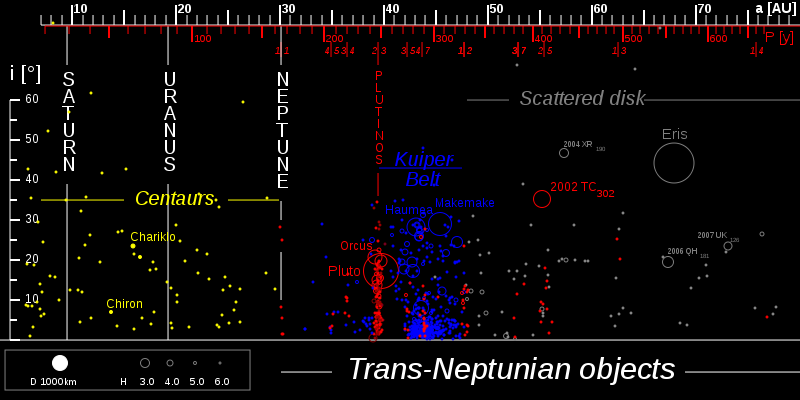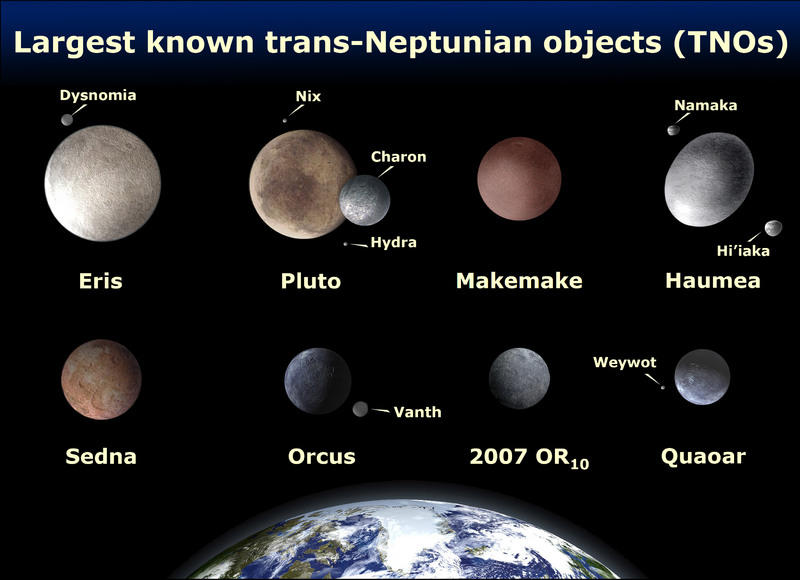What are Trans Neptunian objects?
 Tuesday, May 10, 2011 at 03:33PM
Tuesday, May 10, 2011 at 03:33PM What are Trans-Neptunian objects?
 (Trans-Neptunian objects identified by the red, blue, and white bodies to the right of Neptune's orbit - http://en.wikipedia.org/wiki/Trans-Neptunian_object)
(Trans-Neptunian objects identified by the red, blue, and white bodies to the right of Neptune's orbit - http://en.wikipedia.org/wiki/Trans-Neptunian_object)
A Trans-Neptunian object is any small solar system body that orbits the Sun in a region of space just beyond Neptune. This region of space, often refered to as the Trans-Neptunian region, is made up of three parts: the Kuiper belt, scattered disk, and Oort cloud. Any celestial body found in the Trans-Neptunian region is classified as a Trans-Neptunian object.
Although any celestial body found in the Trans-Neptunian region is considered to be a TNO (because they orbit beyond Neptune), the International Astronomical Union (IAU) established a three-way categorization for all bodies orbiting the Sun in 2006. These three designations would be: planets, dwarf planets, and small solar system bodies. According to this new definition from the IAU, none of the Trans-Neptunian objects are planets, but three of them have been accepted as dwarf planets: Pluto, Eris, and Ceres. Most Trans-Neptunian objects fit in the small solar system bodies category.
Pluto was the first Trans-Neptunian object to be discovered, which was in 1930. Even though it is technically a TNO, Pluto has further been given the designation of dwarf planet.
Because "Trans-Neptunian object" was not even a term beforehand (and Pluto was classified as a planet), you could say that the true first TNO was discovered in August 1992. It was given the name: (15760) 1992 QB1. It was because of this discovery in 1992 that we needed a better way to identify all bodies within our Solar System. Since the discovery of (15760) 1992 QB1, thousands more Trans-Neptunian objects have been identified. A few of the more notable TNOs have acquired names, such as Varuna, Ixion, Quaoar, Sedna, Orcus, Haumea, and Makemake. Currently, Haumea and Makemake are carefully being studied to see if they meet the criteria for being classified as dwarf planets.
 (Comparison of Earth's size to some of the largest known TNOs - http://en.wikipedia.org/wiki/Trans-Neptunian_object)
(Comparison of Earth's size to some of the largest known TNOs - http://en.wikipedia.org/wiki/Trans-Neptunian_object)
Many Trans-Neptunian objects are binaries - two bodies with similar masses that orbit each other. Pluto and Charon are an example of one such binary system found in the Trans-Neptunian region.
The most significant TNO discovered in recent years is Eris. Formerly known as 2003 UB313 and identified in January 2005, Eris is the first Trans-Neptunian object known to be more massive than Pluto.
Reader Comments (1)
Suddenly, this guy in, when we observe, locations suddenly reach out from behind a two-edged pull out nearly three meters long, the width north face fleece clearance of close to half a meter, and even have more than ten centimeters thick grade Sword. Those who are stupidly of the Russian Players will just suddenly saw Zhebing Jian response over all, its a Russian player is called up. "ah, the north face thought and that was Frost Rose Union mobile angel!"